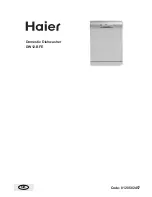
GB -6-
What to do if...
If a fault occurs, before contacting the After-sales Service, make the following checks to try and remedy the problem. Most faults can be remedied by taking the following courses of action,
quickly restoring normal appliance operation.
The appliance...
Possible causes...
Solutions...
...is not working/will not start
-
The appliance must be switched on.
-
Check the household circuit fuse if there is no power supply.
-
The dishwasher door doesn't close.
-
Check if the dishwasher’s door is closed.
-
“Delayed start” option is ON.
-
Check whether the “Delayed start” option (if available) has been selected. If it has, the appliance will only
start once the set time has elapsed. If necessary, set the delayed start to “0” (RESET the appliance).
...shows “F1” on the display or the START
indicator lamp flashes once
-
The water supply temperature is below 3°C.
-
Check that the water supply temperature is above 3°C.
...shows “F4” on the display or the START
indicator lamp flashes 4 times
-
Dirty filters.
-
Clean the filters.
-
Kinked drain hose.
-
The drain hose must not be kinked.
-
Syphon hose connection closed.
-
The closure disk of the syphon hose connection must be removed.
...shows “F6” on the display or the START
indicator lamp flashes 6 times
-
Water tap closed.
-
The water tap must be open.
-
Kinked water inlet hose or clogged inlet filters.
-
The water inlet hose must not be kinked and the relative inlet filter in the water tap connector must not be
clogged.
...shows “F7” on the display or the START
indicator lamp flashes 7 times
-
Water pressure too low.
-
The water tap must be fully open during water inlet (minimum capacity: 0.5 litres per minute).
-
Kinked water inlet hose or clogged inlet filters.
-
The water inlet hose must not be kinked and the relative inlet filter in the water tap connector must not be
dirty.
...shows “F8” on the display or the START
indicator lamp flashes 8 times
-
Dirty or clogged filters.
-
The filters must not be dirty or clogged.
-
Too little water in the dishwasher’s water system.
-
Concave items (e.g. bowls, cups) must be arranged facing downwards in the rack.
-
Drain hose incorrectly fitted.
-
The drain hose must be fitted correctly (for high mounted appliances, leave min. 200-400 mm from the
lower edge of the appliance) - see Assembly instructions.
...shows other “F” faults on the display or
the START indicator lamp flashes Xx times
-
Many different causes.
-
Reset the appliance (see below).
After taking the above course of action, the fault message must be reset. In the majority of cases the fault is thus eliminated.
RESET:
Press the START button for approx. 2 seconds until the indicator lamp switches off or press the RESET button (depending on model)
Close the door.
Water drains automatically for up to 60 seconds.
The appliance is now ready to be restarted.
Crockery and cutlery...
Possible causes...
Solutions...
...are not perfectly clean/have food residues -
Too little space between dishes (incorrect arrangement
of the concave items in the rack).
-
Arrange crockery so that items do not touch each other. Concave items (e.g. bowls, cups) must be
arranged facing downwards in the rack.
-
Too little detergent; detergent too old or incorrectly
stored.
-
If necessary, use more detergent, observing the manufacturer’s indications as regards dosage. Always store
detergent in a dry place and do not store it for excessively long periods of time.
-
Temperature not high enough for heavily soiled crockery.
-
For heavily soiled crockery, select a wash programme with a higher temperature (see table of programmes on page 1).
-
Loading of the dishwasher using lower and upper rack
at the same time with “Half load/Multizone” option.
-
If you select the “Half load/Multizone” option (if available), remember to load only the upper rack or only
the lower rack to increase washing power and thus obtain optimum wash results.
-
Frequent use of Eco 50°C.
-
In the event of frequent use of the Eco 50°C programme (if available), from time to time select the
Intensive 70°C programme (if available).
-
Clogged spray arms; filters dirty or not fitted correctly.
-
The spray arms must not be clogged, the filters must not be dirty and must be fitted correctly (see page 5,
“Maintenance and care”).
-
Spray arms impeded by crockery or cutlery.
-
The spray arms must be able to turn freely and must not be impeded by crockery or cutlery.


























